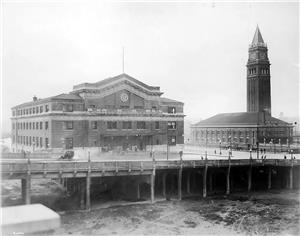This is a reminiscence of trains and the railroad in Seattle during the 1920s and 1930s, and during World War II. It is by Warren Wing (1918-2011), historian, author of To Seattle by Trolley (1988), and To Tacoma by Trolley: The Puget Sound Electric Railway (1995). Heather MacIntosh edited the reminiscence for HistoryLink.org in 1999.
Bright Orange Trains
"My first memories of the station ... I guess I was seven. 1925. My grandfather left for Michigan on the Milwaukee in the morning -- trains left the station either in the morning or in the afternoon then. I always liked the color of the Milwaukee trains. They were bright orange.
At night, off of Spokane Street where I lived as a kid, I could hear the Milwaukee cars passing close by. They'd blow their whistle near the house, sometimes waking me up, especially if I wasn't quite asleep yet. Sometimes I'd be up when they passed by again that night, after stopping at the station.
"Early on, the trains were steam powered. They would later be electric and extremely quiet. Men were afraid of climbing onto the electrified trains.
In A-W-E
"I was always in awe of Union Station, that's a-w-e, compared to King Street Station. They ended up lowering the ceiling there. There just wasn't that central space, you know. The Union Pacific's trains were the best. They were never more than a couple of years old, and always really clean.
"During World War II, the station and the trains were packed. Troops had priority, but no one was ever left behind. The oak benches were really tall, so tall you couldn't see over them sometimes. People slept there waiting for trains. These tall benches were everywhere (around the country). People didn't act like they do in airports nowadays. They just waited because they knew there wasn't anything they could do about the trains coming.
"Trains were so crowded during the war, that people often had to sit on their baggage because there just weren't enough seats. There would sometimes be about 100 or so people on each car. The line for the dining car was tremendous, so long that people would have to wait in line for the next meal after finishing their last one. I was a mess sergeant on troop trains."
One of Warren Wing's most poignant memories of this period was leaving Seattle on Christmas Eve: "I had a little brother. Leaving him right before Christmas was just terrible." The trains ran incessantly during the war, fast and furiously, pushing the machines and the infrastructure to its limits. "By the end of the war, trains were breaking down all over the place."
"Although I got paid five cents a mile to get home ... I could have walked all the way and kept the money, but I didn't. I took a train home and it took forever. Trains broke down all along the way; they'd replace a train and it'd break down too."
All Shook Up
Warren's interests in trains continued long after the war. He founded the Northwest Railfans Group. "The railroad club met at Union Station, in the old Milwaukee Lady Room which still had that name labeled over the door in gold. A 1968 earthquake literally shook the group out of its meeting place."
When asked for his impression of the station, he remarked, "The station was magnificant ... massive, truly massive."

